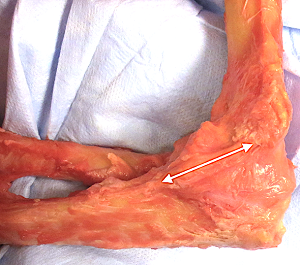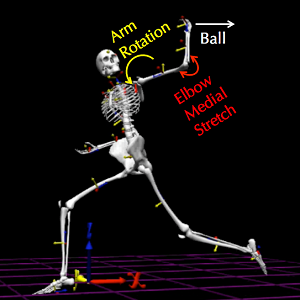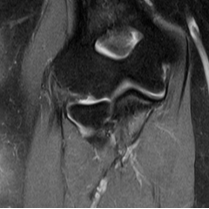Baseball-Related Elbow Injuries
Anatomy and function of the elbow

The elbow is a hinge joint between the upper arm bone, which is called the humerus, and the lower arms bones, which are called the radius and the ulna. The ulna is on the inside of the elbow, also called the medial side. The radius is on the outside of the elbow, also called the lateral side. For the elbow to function normally, it is stabilized by strong ligaments on both the inside and the outside. These are called the collateral ligaments. These ligaments prevent the elbow from bending to the side. A ligament is a band of connective tissue that connects two bones together. In the elbow, the inside ligament is called the medial collateral ligament or the ulnar collateral ligament. The outside ligament is called the lateral collateral ligament or the radial collateral ligament. These ligaments can be injured by dislocations of the elbow, fractures of the elbow, surgery upon the elbow, or repetitive overuse. In the picture the white arrow shows the ulnar collateral ligament. The joint surfaces are coated in a smooth, slippery cartilage surface. This cartilage surface is ten times more slippery than wet ice! This surface allows for smooth, frictionless motion of the elbow.
Baseball pitching

The overhand baseball pitch is among the fastest and highest stress athletic motions known. Within this motion, rotational speeds exceed 7000 degrees per second, or the equivalent of a tire turning at 60 miles per hour. Most of the speed of the baseball pitch is produced in the legs and trunk. This speed is then transferred into the arm as the arm is cocked. The arm then rotates and accelerates and the ball is released. During this cocking process, the inside of the elbow experiences "stretching" forces, while the outside of the elbow experiences "compressing" forces.
Tears of the Ulnar Collateral Ligament or "Tommy John" Ligament

The inside ligament, the ulnar collateral ligament (UCL), keeps the inside of the elbow from stretching apart during the pitching motion. The forces produced during the pitch exceed the strength of the UCL. Tear of the UCL are one of the most common pitching-related injuries. Pitchers who tear this ligament often lose pitching speed, have pain and are unable to pitch. Treatment is customized to the patient and can include rest, therapy, injections, or surgery.


Capitellar Osteochondritis Dissecans


In addition, the same forces can create damage to the outside of the elbow, the "lateral" side. The most common problem on the outside of the elbow is damage to the cartilage and bone beneath the cartilage. This damage is usually on a portion of the upper arm bone called the capitellum and is called osteochondritis dissecans or "OCD". Usually this problem can be treated with rest, especially when the growth plates are open. Rarely, surgery is performed. Two surgeries exist for this problem. In the first, arthroscopically small holes are created in the bone to allow stem cells from the marrow to heal the damaged bone and cartilage. This procedure is called a microfracture. In the second the bone and cartilage damage is replaced with a cadaver graft.
Other Injuries
Baseball pitching can be associated with a wide variety of other elbow injuries, such as bone spurs, fractures, tendon tears and tendonitis. In young pitchers who are still growing, the growth plate connected to the UCL can be injured. This injury is called "Little Leaguer’s Elbow" and almost always resolves with an extended period of rest as this injury should be treated like a broken bone.
Click here to download the PDF.
You will need the Adobe Reader to view and print these documents 
